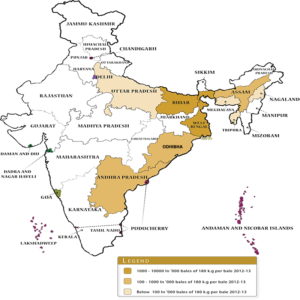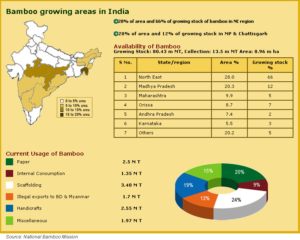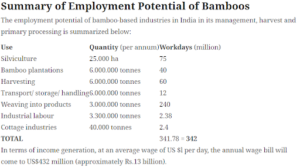With their insignificant coverage of total cultivated area, jute and bamboo play a predominant role in India’s economy by generating employment, earning foreign exchange, solving many of the socio-economic problems, etc.
Dimensions
- Major Areas for bamboo and jute production
- Packaging rules for jute
- Present analysis and future potential for bamboo industry
- Employment potential
Content:
Major Areas for Bamboo and Jute Production:
Jute Cultivation in India:
- Jute is an important natural fibre crop in India next to cotton. In trade and industry, jute and mesta crop together known as raw jute as their uses are almost same
- Jute cultivation is mainly concentrated in the eastern and north eastern India while that of mesta cultivation is spread almost throughout the country.
- The crop can be grown in low, medium and high land situations, both moisture stress and water stagnating conditions.
- White Jute can be grown comparatively in low land situations while that of Tossa Jute prefers medium and high land situations.
- Mesta is grown in almost all over the country.
- In a major part of Jute area, particularly in North Bengal, Bihar and North-Eastern States, the soil is acidic in nature. However, the Jute crop is growing in these areas in an existing situation adjusting the crop sequence.
The Ganges delta contributes more than 80% of the jute production in the world.
The Ganges delta can be subdivided into the following geo-graphical regions in terms of jute cultivation:
- Jat Area (Brahmaputra Alluvium): This comprises part of the districts of Dhaka, Mymensingh, Tangail, and Comilla of Bangladesh. The area annually receives fresh deposit of silts carried down by the flood water. Soils are acidic in, the texture varies from sand loam to clay loam. According to commercial quality, the best quality jute, the Jat type, grows in this area.
- District Area (Ganges Alluvium): This comprises part of the districts of Kushtia, Jessore, Khulna, Rajshahi, Pabna, and Dhaka of Bangladesh and major portion of West Bengal of India. This area has soil of slight alkaline clay loam to light loam in gray to dark gray color. The type of jute grown in this area is known as District Jute, which is next to Jat Jute in order of quality. The jute fibre grown in this region is further divided into two major varieties, such as: Hard District Jute and Soft District Jute.
- Northern Area (Teesta Silt): This comprises part of Dinajpur, Rangpur districts, East Bogra, and Sirajganj of Bangladesh and some parts of North Bihar Purnea and West Bengal of India. The region has sandy soil with low moisture retention capacity. Soil retention is slightly acidic. Northern type of Jute is inferior quality of the three commercial types.

Bamboo Cultivation in India:
- Bamboo is a versatile group of plants which is capable of providing ecological, economic and livelihood security to the people.
- India has the highest area (13.96 million ha) under bamboo and is the second richest country, after China, in terms of bamboo diversity with 136 species (125 indigenous and 11 exotic).
- The annual production of bamboo in India is about 14.6 million tonnes and annual yield varies from 1 to 3 tonnes per ha, a major issue to be addressed

Packaging rules for jute:
- Under the Jute Packaging Materials (Compulsory use in Packing Commodities) Act, 1987, the Government is required to consider and provide for the compulsory use of jute packaging material in the supply and distribution of certain commodities in the interest of production of raw jute and jute packaging material and of persons engaged in the production thereof.
- In Oct 2020, Cabinet approved Extension of Norms for Mandatory Packaging in Jute Materials.
- Now, 100% of the foodgrains and 20% of the sugar shall be mandatorily packed in diversified jute bags.
- Nearly 3.7 lakh workers and several lakh farm families are dependent for their livelihood on the jute sectors.
- This decision will give an impetus to the diversification of the jute industry.
- It will also benefit farmers and workers located in the Eastern and North Eastern regions of the country.
Uses of Raw Jute:
- Raw jute was originally considered as a source of raw material for packaging industries only.
- But it has now emerged as a versatile raw material for diverse applications, such as, textile industries, paper industries, building and automotive industries, use as soil saver, use as decorative and furnishing materials, etc.
- Raw jute being biodegradable and annually renewable source, it is considered as an environment friendly crop and it helps in the maintenance of the environment and ecological balance.
- Now-a-days, the people of the world are very much worried about the growing environmental pollution and ecological degradation and they are trying to find out a solution to this problem.
- In the process, they find out the virtue of the use of natural fibre like raw jute and as such there is a prospect of the crop in future. Jute as a natural fibre has some definite inherent advantages.
- Its silky luster, high tensile strength, low exhaustibility, considerable heat resistance and long staple length are the qualities that can not be matched by synthetic fibre.
- Further attraction of Jute lies in its easy availability, inexhaustible quantity at a comparatively cheaper rate.
- Moreover, it can easily be blended with other natural and man made fibres.
Present analysis and future potential for bamboo industry:
- Bamboos are aptly called the poor man’s timber and are found in great abundance. Their strength, straightness and lightness combined with extraordinary hardness, range in sizes, abundance, easy propagation and the short period in which they attain maturity make them suitable for a variety of purposes.
- Presently, India is a net importer of bamboo.
- During 2015-16 & 2016-17 the export of bamboo & bamboo products was Rs. 0.11 crore and Rs. 0.32 crore respectively while the import was Rs 148.63 crores and Rs 213.65 crores
- Bamboo Industry has potential to be worth Rs 30,000 crore in India
- It means that there are greater opportunities to harness the market potential by increasing its production and ensuring establishment of a proper value chain system.
- In most of the hilly States of the country, bamboo is used as building material/construction material.
- It also has a niche as basic raw material in other countries with various traditional and an ever-increasing range of contemporary uses/applications in industries like paper and pulp, construction, furniture, textile, food, energy production etc.
- This is especially important from the potential of bamboo based livelihoods and employment for rejuvenating the rural economy and doubling of farmers’ income.
- Keeping in view the vast untapped potential of the bamboo sector, boost domestic cultivation of quality and appropriate species for supply to our industry, the restructured National Bamboo Mission (NBM) has been approved for implementation across the country.
Restructures NBM:
- The amended National Bamboo Mission was launched in the year 2018-19 for development of the complete value chain of the sector.
- The Mission is being executed in a hub and spoke model, with the main objective of connecting farmers to markets so as to enable farmer producers to get a ready market for the bamboo grown & to increase supply of right raw material to domestic industry.
- In addition, the bamboo ecosystem has been energized with 23 States being supported, including all the eight States of the North East.
- 10 most important species that are required by the industry have been recognized and quality planting material is being made available to growers for plantations.
Employment Potential:
- Bamboos generate large-scale rural employment in the management of bamboo forests, and harvesting, collection, transport, storage, process-ing and utilization of bamboo.
- On the basis of current production of bamboo and its uses in India, it is estimated that a total of 432 million workdays and Rs.13 billion in wages is generated annually.
- bamboo development is viewed as an instrument of poverty alleviation and employment generation for skilled and unskilled persons, especially unemployed youth particularly in the rural sector through eco rehabilitation purposes

Mould your thought: Analyse the potential of jute and bamboo for India’s Development.
Approach to the answer:
- Introduction
- Write about the production of jute and bamboo
- Discuss newer uses of these crops
- Discuss the future potential / employment benefits
- Conclusion
















